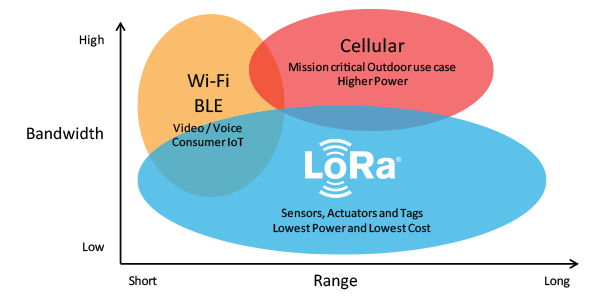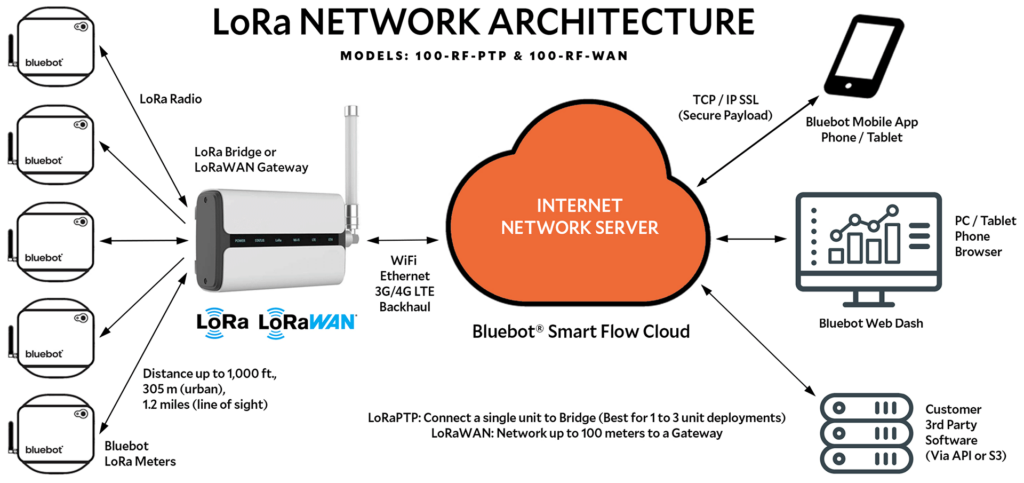

LoRa vs LoRaWan – what are the key differences today’s businesses, developers, and network architects need to be aware of?
As the IoT (Internet of Things) landscape continues to evolve – a market that’s expected to surpass $150 billion before 2030 – both LoRa and LoRaWAN are emerging as critical technologies, enabling the future of connectivity.
These technologies are closely connected, but they aren’t exactly the same.
In this guide, we’ll introduce you to the differences between LoRa and LoRaWAN and provide guidance on which is right for you.

LoRa stands for “Long Range” in the world of connectivity. It’s a wireless technology designed to send data over long distances while using little power.
LoRa uses a special type of signal to send data and works in low-frequency bands. This makes it perfect for IoT applications because it can maintain connections through obstacles like buildings and over long distances.
This efficient wireless long-range communication technology is ideal for battery-operated devices that need to operate over extended periods without frequent recharging or replacement.
Unlike traditional communication methods such as cellular networks, which can be power-hungry and expensive, LoRa provides a cost-effective solution for wide-area connectivity.
LoRa and the LoRa alliance have gained significant attention in recent years, as the use cases for this technology have continued to evolve.
In smart agriculture, LoRa-enabled sensors can monitor soil moisture, weather conditions, and crop health over large farm areas.
At Bluebot, we have a LoRa water meter that gives you total control of your water usage from anywhere with ultimate connectivity and unmatched reliability.
It offers real-time alerts for leaks or overuse, eliminating surprises on your water bill and providing efficient water management for various applications.
In smart city infrastructure, LoRa technology is used for monitoring street lighting, waste management systems, and parking meters.
However, LoRa itself only handles the physical layer of communication (data transmission and reception).
For a complete approach to network management, security, and the management of IoT devices, LoRaWAN networks are necessary.

LoRaWAN stands for “Long Range Wide Area Network”. Like LoRa, it’s a type of network that helps devices communicate with each other over long distances while using less power.
Even though LoRaWAN uses the same frequency bands as LoRa, it adds more layers to manage the network, keep data secure, and help devices talk to each other.
This protocol is designed for low-power networks, making it perfect for situations where devices need to send messages across long distances.
LoRaWAN gateways serve as bridges between the LoRaWAN network and IoT devices. They can support many devices within a single network, making them ideal for large-scale deployments.
Gateways receive wireless transmissions from devices enabled with LoRa technology and forward them to a central network server for processing.
LoRaWAN adds different technologies to the LoRa system, like adaptive data rate mechanisms. These mechanisms adjust how each device communicates based on where it is and the condition of the network.
LoRaWAN can also enhance security with end-to-end encryption, protecting data in sensitive IoT networks.
The robust capabilities of LoRaWAN make it suitable for various IoT applications.
In agriculture, it can allow professionals to monitor soil conditions and crop health.
In smart cities, it can support environmental monitoring and street lighting systems.
The Bluebot LoRaWAN water meter connects to the cloud from thousands of feet away, streaming water data to your app or dashboard without needing Wi-Fi.
With a dedicated power source and flexible connection options, Bluebot ensures reliable, hassle-free water monitoring and management.
LoRa and LoRaWAN are two distinct technologies, often used simultaneously in the IoT landscape. However, there are some significant differences between them based on a technical perspective.
Here are some of the biggest technical differences to be aware of:
LoRa refers specifically to the physical layer technology responsible for the modulation and demodulation of radio or data signals. It leverages Chirp Spread Spectrum (CSS) modulation to achieve long-distance communication with low power consumption.
In contrast, LoRaWAN is a network protocol that operates on top of the LoRa physical layer. It defines the communication rules, such as the message formats and network interactions, to ensure efficient and scalable data transmission over the network.
LoRa is a technology that operates on a P2P (point-to-point), P2MP, or Mesh communication system.
LoRaWAN, alternatively, has a star topology network structure. This means that end devices communicate with LoRAWAN gateways, which then relay messages to a central server, which manages routing and network traffic.
This structure allows for greater scalability and more efficient management of large numbers of devices within a network for larger-scale projects.
From a data transmission perspective, LoRa delivers the physical means to transmit data over long distances with varying data rates and spreading factors.
However, it doesn’t handle the network protocol.
LoRaWAN adds this protocol layer to manage transmission, handling retransmissions, acknowledgments, and data rate adaptations according to network conditions.
LoRa doesn’t inherently feature any security mechanisms. However, LoRaWAN uses end-to-end encryption to secure data transmitted between end devices and network servers, adding an additional layer of security to LoRa ecosystems.
It can use both network and application-level encryption keys to ensure that the data remains confidential and protected from unauthorized access throughout its journey across the network. This robust security framework is essential for maintaining the integrity and privacy of IoT communications.
So in the battle of LoRa vs LoRaWAN, how do the strengths and weaknesses of each solution compare? Both solutions have benefits for IoT applications, but they also have their limitations.
In many environments, LoRa and LoRaWan work seamlessly together, facilitating a wide range of IoT use cases, with long-range, low-power connectivity. Both of these technologies are frequently used with IoT sensors and systems in:
Ultimately, deciding between LoRa and LoRaWAN means carefully considering your use cases and goals. There are numerous factors that can affect your choice, such as:
At the end of the day, your specific use case will help you to identify which technology you need.
That said, LoRaWAN is generally the preferred option for large-scale operations that require a comprehensive end-to-end solution for data transmission and wide-area network control.
Still need help deciding between LoRa and LoRaWan? Contact our team today and we’ll help you find the best solution for your needs.
While LoRa and LoRaWAN are two different technologies, most companies won’t actually need to choose between the two.
LoRa is the underlying wireless technology that gives companies the physical layer they need to power IoT use cases. LoRaWAN gives you the protocol and network layer you can use to manage your communication systems.
Both of these technologies work together to provide a comprehensive ecosystem for IoT connectivity, enabling a wide range of applications.
Put LoRa and LoRaWAN technology into action with Bluebot’s LoRa water meter and LoRaWAN water meter today.